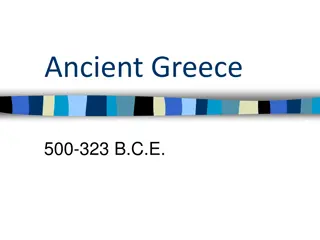The Ancient Olympic Games: A Glimpse into History
Explore the origins and customs of the ancient Olympic Games, where city-states competed in sports competitions every four years. Delve into the significance of the opening ceremony, the duration of the games, and the essence of unity it brought among diverse communities. Discover the evolution of athletics and the timeless values embedded in this historical event.
Uploaded on Sep 19, 2024 | 1 Views
Download Presentation

Please find below an Image/Link to download the presentation.
The content on the website is provided AS IS for your information and personal use only. It may not be sold, licensed, or shared on other websites without obtaining consent from the author.If you encounter any issues during the download, it is possible that the publisher has removed the file from their server.
You are allowed to download the files provided on this website for personal or commercial use, subject to the condition that they are used lawfully. All files are the property of their respective owners.
The content on the website is provided AS IS for your information and personal use only. It may not be sold, licensed, or shared on other websites without obtaining consent from the author.
E N D
Presentation Transcript
THE OLYMPIC GAMES IN THE ANCIENT TIMES Model Junior High School of Evangelikh Scholi Smyrnis
Introduction Giorgos Sakellarakis
GENERAL INFORMATION ABOUT SPORTS The word athlete" derives from the ancient noun athlon which means the struggle for a prize. Over the years the word has gained wider meaning. Sports today is one of the most widespread ways of exercise, practiced by the majority of the population in Greece and around the world. Sport can be either amateur or professional. Both categories are divided into two smaller, team sports, such as football and individual sports, such as track and field. Sports can take the form of games or races. The main goals of sport are physical exercise, entertainment and cultivation of the spirit. The benefits of sports are many. First of all, with the sport a person acquires a solid body and good physical condition. Also, the psychological sector is being strengthened, that is relief from stress and daily routine. In addition, the ethical sector is being promoted, the obedience to rules, austerity, and respect to others.
THE APPEARANCE OF OLYMPIC GAMES IN THE ANCIENT TIMES In the historical era, the Olympic Games were held after the summer solstice every four years. This four-year period was called penthetiris" because the ancients included both years of the organization, marking the beginning and the end of the period. These time periods were called by the serial number of each Olympiad and served as a time reference. The first recorded celebration of the Olympic Games in ancient world was in Olympia, in 776 BC. It is almost certain that this was not the first time the Games were held. Back then the Games were only local and only one race, the race of the stadium.
THE OPENING CEREMONY On the first day of the morning, the swearing ceremony was held for the athletes to abide to the rules of the games in front of the statue of the Orthodox Zeus. Thereafter, the athletes were recorded, divided by events, and their draw by the pair or the sequence to be played. In the afternoon of the first day sacrifices were made to the of sacred Alti . Also philosophers, historians and poets gave lectures and various meetings have been held.
THE DURATION The son of Endymion, a mythical ancient her made with the Moon fifty daughters, which since then represented the fifty months that formed the period between the games, and so the Olympic Games were held every four years.
THE ESSENCE OF OLYMPIC GAMES The Ancient Olympics brought all the city-states near, and even the cities that were in war, sent their athletes to participate in the races. The fact that all countries were breaking their national and racial differences, demonstrated the importance of the event. Primarily, the Olympic Games for the ancient Greeks highlighted the abilities of the human race. And not with obvious abilities such as strength, speed and endurance. The man increased his ability to push his forces to the ends, breaking his previous achievements with new, more grandiose and impressive. For all fights, a sports organization was sacred and respected. The Olympic games gave ordinary people an opportunity to exalt themselves through its pure power their will, their ability and their talent for sport. Although participation in the Olympic Games was the exclusive prerogative of men, all women, children and other men of the population felt proud of their compatriots being distinguished. The athletes themselves felt blessed and lucky if they were discriminated against, but if they did not, they felt they were involved in such a racing event.
THE OLYMPIC TRUCE The idea of the Olympic Truce comes from the deep conviction that sport and Olympic ideals can contribute to the creation of a peaceful and better world. Initiatives to promote dialogue, reconciliation, mutual understanding, solidarity and peace are the key objective of this effort. The Olympic Truce, just as a global effort, aims to emphasize the importance of respect for peaceful coexistence.
WHAT THE OLYMPIC GAMES ATTITUDE SUGGESTS The importance of trying for the Olympic Truce is that it combines the strength of the Olympic movement, its credibility and the enthusiasm of younger generations all over the world who want to work together for peace under the care of the Olympic movement. The aim is to connect the spirit and dynamism of these movements with specific issues.
PRIZES OF OLYMPIC GAMES The material prize was of little or great value and was a recognition of the athlete s struggle to winin the games. Between 1.200-900 BC the prize was animals, slaves, etc. After 884 BC a sacred olive wreath is established as a prize. The wreath of the olive tree was the greatest distinction for every athlete but also for every ordinary citizen Then, in the years of Solon, the material prize prevails. The prizes were in a prominent place to increase the interest of the athletes and to give them more motivation to participate in the Olympic Games. In the Roman and Byzantine years, where the athletes' consciousness begins to change, the prize of great economic value prevails. Now the moral element has begun to subside, and sport is becoming more and more professional. But the immense importance of victory in the Olympic Games was immeasurable. These victories were celebrated by great ancient poets like Pindaros and Simeonidis.
HONORING OF THE OLYMPIC GAMES WINNER When the Olympic winner returned to his city, he enjoyed great prices. Since a city that gave birth to a Olympic winner did not need walls, a part of them was demolished, and the winner was entering the city from the new entrance, elevated to a magnificent chariot with four white horses. Then there was a magnificent parade that ended up in the holy temple of the patron saint of the city, where the sacrifices were made and the athlete deposited his winning wreath. There was a gala dinner, attended by the whole city. Other privileges for the winners were their lifelong feeding at public expense, as well as the exemption from taxes. In Sparta, the winner was given the right to he fights beside the king, an enviable thing, if you think the Spartans were one especially warlike people. In public events the Olympians have always had honorable position, while many times the name it was scribbled on columns, which were placed in a prominent position. In a few cities even the Olympians were worshiped as heroes even after their death.
Road Racing Theodora Fotopoulou
Road Racing The simple race, the stadium was the first Olympic game. The first reference to race is in the Iliad where the winner was Odysseus.
Road Racing According to tradition, Idaios Hercules, the ancestor of the Illyrian leader, was the first who organized the game of the road. Additionally, he set the length of the stadium (600 feet), in Olympia. He put his brothers, Kouretes, to race and crown the winner with a wreath from wild olive.
Until the 15th Olympics, the athletes who took part wore a small apron later they were racing naked, risking their performance in walking and running
Road Racing Types Olympic Games: Stadium Dolichos Diablos Hoplite
Dolichos The dolichos was a half-way race in ancient Greece, about 4800 meters in length. In 720 BC was also introduced to the ancient Olympic Games. The average distance of the race was about 18-24 rounds, or about 4800 meters. the racers started and finished the race within the stadium, but the course of the race extended to the streets around the area of the stadium of Ancient Olympia.
Hoplite He was introduced to the Olympic Games in 520 BC. It is a speed road where the runner runs wearing a bronze defense armor (helmet, tongs, shield). The road hopper's route was 2 to 4 stages . The hoplite road is considered an epic race in honor of someone dead hero.
o THE STREET RACE OF "Ilion Parthenon" Pausanias also mentions this race, which took part women dressed in a short sleeve, the right shoulder naked and the hair down.
CHILDREN Adolescents were racing only at the simple "stadium (the race of one route.)
THE END OF ROAD The end was the point where the prize was, while the spectators stood right and left along the sandy path which was six hundred Olympic feet (about 192 meters) long.
The equestrian Games in ancient Greece Papageorgiou Kalliopi
Preface of Equestrian Games In ancient Greece the equestrian games were taking place during the Olympic Games as well as in several nationwide events, like Pytheia or Nemea. They were consisted by several kinds of rails, which took place for the first time at 680B.C. when the duration of the games was extended as to provide enough time for the new competitions and the equestrian games, which were a speed race between the horse riders. Furthermore, the winner was not the horse rider or the chariot rider (Iniohos) but the owner who breeds the horses, which were the ones to be given the prize.
Mythology According to Greek mythology the first chariot games took place in Olympia, between Pelopas and Oinomaos, as well as mythic Hercules took place in a chariot race at Troizina with Iolaos who was his horse rider. The horse that took place in the race was called Areionas and his owner was god Poseidon which was protector of all chariot races. Other earlier reports for chariot races are mentioned in Iliada,where Achilleas organized a chariot race to pay honor to late Patroklos who was then killed in battle.
Competition and the first games The chariot games derive from the ancient Achaia s military tradition. At 680 BC first came the Tethrippon, at 500BC the Apene, at 408BC the Synoris and at 384 BC the Tethrippo Polon which was a variation of Tethrippo game replaced it temporarily, and at 268 BC there is the Synoris Polon. The true equestrian games were the horse race of Kelites, the Kalpi and the Polon horse race. The first horse race game took place at 648 BC during the 33rd games. At 71st games of 469BC we meet the event of Kalpi, where female horses took place on the race. At last, on the 131st games of 256 BC the horse ride of Polon.
Apene Synoris- Polon The Apene game began at 500BC at the 70th games and the chariot was driven by two mules. The game was deleted on 444 BC at 84th games. The Synoris game the chariot was driven by two horses. It first organized at 408BC on the 93th Games. The Polon race, was a variation of the Kellis game, were they used young horses.
The types of games: The game of the horseriders, in which the competitors took place just by riding their horse was called Kellis. The opening ceremony was starting with a procession at the hippodrome, when the preacher of the game announced the names of the riders and the horses owners.
Kellis The Kellis game was a rider on a horse witch did six times the round of the hippodro me.
The hippodrome: Chariot races and horse races were taking place at the Hippodrome of ancient Olympia, which was on the south east side of Olympia, on the long flat side of the stadium. The location of the hippodrome was unknown up until the beginning of the 21st century, as its location was buried under concentrated sediment of the river Alfeios. There by on 2008, a mission of the German Archaeological Institute used a radar in order to find the premises of the hippodrome and they referred they found the place were Pafsanias has described it which has visited the cite during the 2nd century A.D. and gave a analytical description of the monument and its dimensions.
The hippodrome _2: The hippodrome was divided in two corridors by a wall of stone or wood which was called embolon. The horses and the chariots which took place on the ride, followed the circular ride around the embolon facing east, when the number of the circles differentiated depending on the event. The cite of the game was surrounded by natural or artificial stands for the audience, when the Ellanodikes were watching the game by the west side of the north perimeter. Departure and finish line were limited by poles, when a smaller pole by the name Nyssa was on the turning point. Oposite to the Nyssa was Taraxippos a kind of altar, which was maybe orientated by the sunset position which made it difficult for the horses and the riders to see during the race.
The chariots: They were using battle chariots for the game, which were modified and they were wooden trolleys with two big wheels open by the back side. The drivers feet were stabled on the base but as the vehicle was supported by the axel of the wheels the ride was bumpier. Except for the number of the horses and the number of the rounds the main difference between the chariots of different type of race was that in Tethrippo and Synorida there was only one rider but two on the other sports. The most dangerous site of the course were the turns at the end of the runway, where the accidents were usually lethal. If the chariot lost balance and inverted due to full speed on the turn, the driver risked to be crashed by its own vehicle, its horses or the rest of the chariots following behind him, and if he didn t turn quickly he risked of crashing on the wall of the racing field and be ejected.
Mechanical structures: They were using different mechanical devices like Yspligges, obstacles, which were positioned in front of the competitors on the race start line and they decreased them in order to start the game. According to Pafsanias, they were invented by the architect Kleiota and they fell down earlier in order to let the chariots in the external side of the railway to start first, before the ones in the interior side which had a shorter road to ride on the turns. At the same time, the competitors placed the most young and powerful horse on the right side of the chariot as to make it easier to drive the chariot on the turns. An other mechanical structure used was the eagle and the dolphin which were used to sign the start of the game and where lowering by the number of rounds left to finish. These where embodied figures on brass plates positioned on the start line.
Chariot riders and Horse riders: At the chariot races, the owner of the charriot and the horses was a different person than the rider. The winner was not the rider of the charriot (iniohos) but its owner (ippotrofos). The owner took the prize, and the riders were given a wooden stripe which was placed on their forehead as lower honorary distinction. The chariot rider should drive the chariot without loosing its coarse, difficult enough especially on the Tethrippos (4 horses chariot), he should know how to use the whip and hold the reins safely as to avoid collision or falling by the chariot on the turns. During the game, the rider was trying to take advantage of the inner corner of the railway as to run a shorter distance. Women were not allowed to take place or watch the Olympic games. The equestrian games were the only exclusion of this rule because the winner of the Olympic game was the owner of the horse, so a woman could take part in the game with a male rider. The most famous case was Kyniska from Sparta, witch took place on the games and won the price twice.
Chariot riders and Horse riders 2: The rider of the chariot was usually a member of the family to which the chariot belonged and in some cases a slave or professional who was in duty especially for the game. Driving the chariot was difficult and needed strength, skill and especially patience. In opposite to the rest of the olympic games the contestants were not naked for security reasons due to the amount of dust arousing during the game. The drivers wore a cloth with long sleeves, long down their ankles and striped a belt on their waist. It was called Xystis. However, in order not to drift and inflate from the air during the race, there were two straps crossed in the back.
Tethrippos The Tethrippos was a small chariot with two wheels, which was led by one rider and 4 horses and performed 12 rounds. From 680BC up to 241AD there were totally 53 known and 3 unknown Olympic games winners of this game from Greece and Italy.
PANKRATION Aggelos Sarlakis
Pankration(part 1) Pankration was a sport of the Ancient Greeks and it was an empty-hand submission sport with scarcely any rules. The athletes used boxing and wrestling techniques, but also others, such as kicking and holds, locks and chokes on the ground.
Pankration (part 2) The name of the martial art defense and sport competition is two words pan and kratos Pan means all and kratos means power , or the one who has everything. The athletes engaged in a pankration competition were called the pankratiasts
History of pankration In Greek mythology, it was said that the heroes Hercules and Theseus invented pankration as a result of using both wrestling and boxing in their confrontations with opponents. The mainstream academic view has been that pankration developed in the archaic Greek society of the 7th century BC.
History of Pankration(2) However, pankration was more than just an event in the athletic competitions of the ancient Greek world; it was also part of the arsenal of Greek soldiers including the famous Spartan hoplites and Alexander the Great's Macedonian phalanx. By the Imperial Period, the Romans had adopted the Greek combat sport (spelled in Latin as pancratium) into their Games
Types of pankration Ano Pankration (Upper Pankration): contestants had to fight upright. As the main goal was to knock down the opponent, punches, kicks and all kind of lethal blows were usually performed. Kato Pankration (Lower Pankration): started with the first falling on the ground of some of the competitors. Here grappling, joint locking, and even strangulation were used as more effective methods of fighting on the floor
Rules of Pankration There were only 2 rules in Pankration: 1) It was forbidden to bite 2) It was forbidden to gouge an opponent's eyes, nose, or mouth with fingers Anything else - such as kicking in the belly and the genitals - was permitted and even expected. A sparring ended either by submission (the opponent would raise his index finger as a sign of being defeated) or by death.
Techniques of Pankration Initially, the pankratiasts fought nude, with oiled bodies and bare hands. Later, they wore thong wrappings around their hands and forearms.The athletes used boxing and wrestling techniques, but also others, such as kicking and holds, locks and chokes on the ground
Techniques of Pankration(2) The straight kick with the bottom of the foot to the stomach ( laktisma "kicking in the stomach") was apparently a common technique
Pankration in Olympics In 648 BCE, the Pankration was introduced as a sporting event in the 33rd Olympic Games where it joined boxing and wrestling in a category called heavy events. That special group of sports was reserved for the best athletes with the greatest strength and stamina.
Famous olympic pankratists . Theagenes of Thasos Arrichion Kleitomachos Polydamas of Skotoussa Dioxippus Timasitheus of Delphi Sostratus of Sicyon Hysmon Antiochus of Arcadia
Arrhichion Arrhichion was a champion pankratiast in the ancient Olympic Games. He died while successfully defending his championship in the pankration at the 54th Olympiad (564 BC). Arrhichion has been described as "the most famous of all pankratiasts According to Pausanias: While he was contending for the wild olive with the last remaining competitor, the latter got a grip first, and held Arrhachion, hugging him with his legs, and at the same time he squeezed his neck with his hands. Arrhachion dislocated his opponent's toe, but expired owing to suffocation; but he who suffocated Arrhachion was forced to give in at the same time because of the pain in his toe. The Eleans crowned and proclaimed victor the corpse of Arrhachion
Modern Pankration At the time of the revival of the Olympic Games (1896), pankration was not reinstated as an Olympic event. Amateur pankration was first introduced to the martial arts community by Greek-American combat athlete Jim Arvanitis in 1969 and later exposed worldwide in 1973 when he was featured on the cover of Black Belt. Arvanitis continually refined his reconstruction with reference to original sources
Modern Pankration(2) The International Olympic Committee (IOC) does not list pankration among Olympic sports . However, the efforts of Savvidis E. A. Lazaros, founder of modern Pankration Athlima, the technical examination programma, the endyma, the shape of the Palaestra and the terminology of Pankration Athlima, the sport was accepted by FILA, known today as United World Wrestling, which governs the Olympic wrestling codes, as an associated discipline and a "form of modern Mixed Martial Art". Pankration was first contested at the World Combat Games in 2010. The international federation is United World Wrestling
Conclusion Giorgos Sakellarakis























